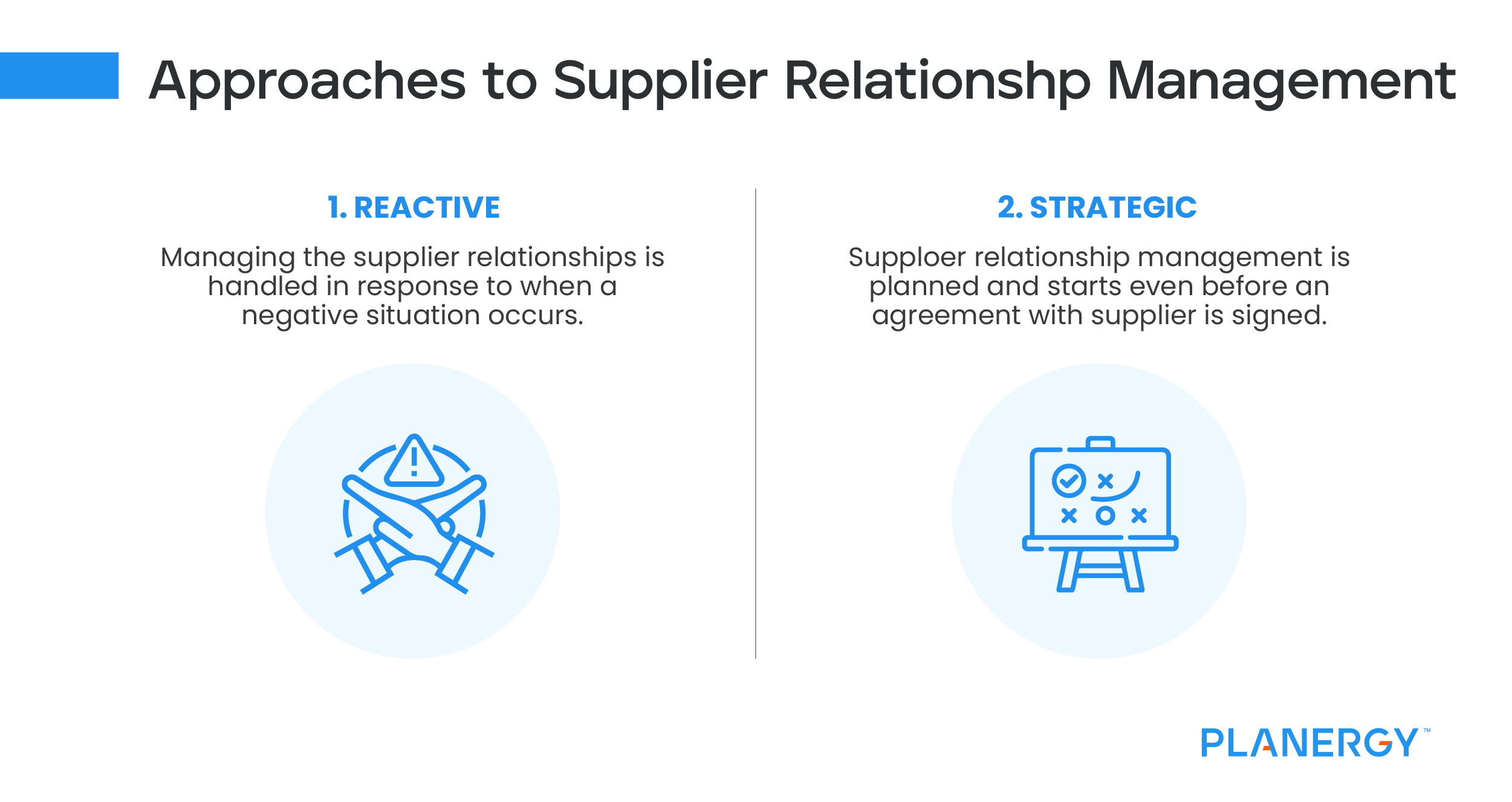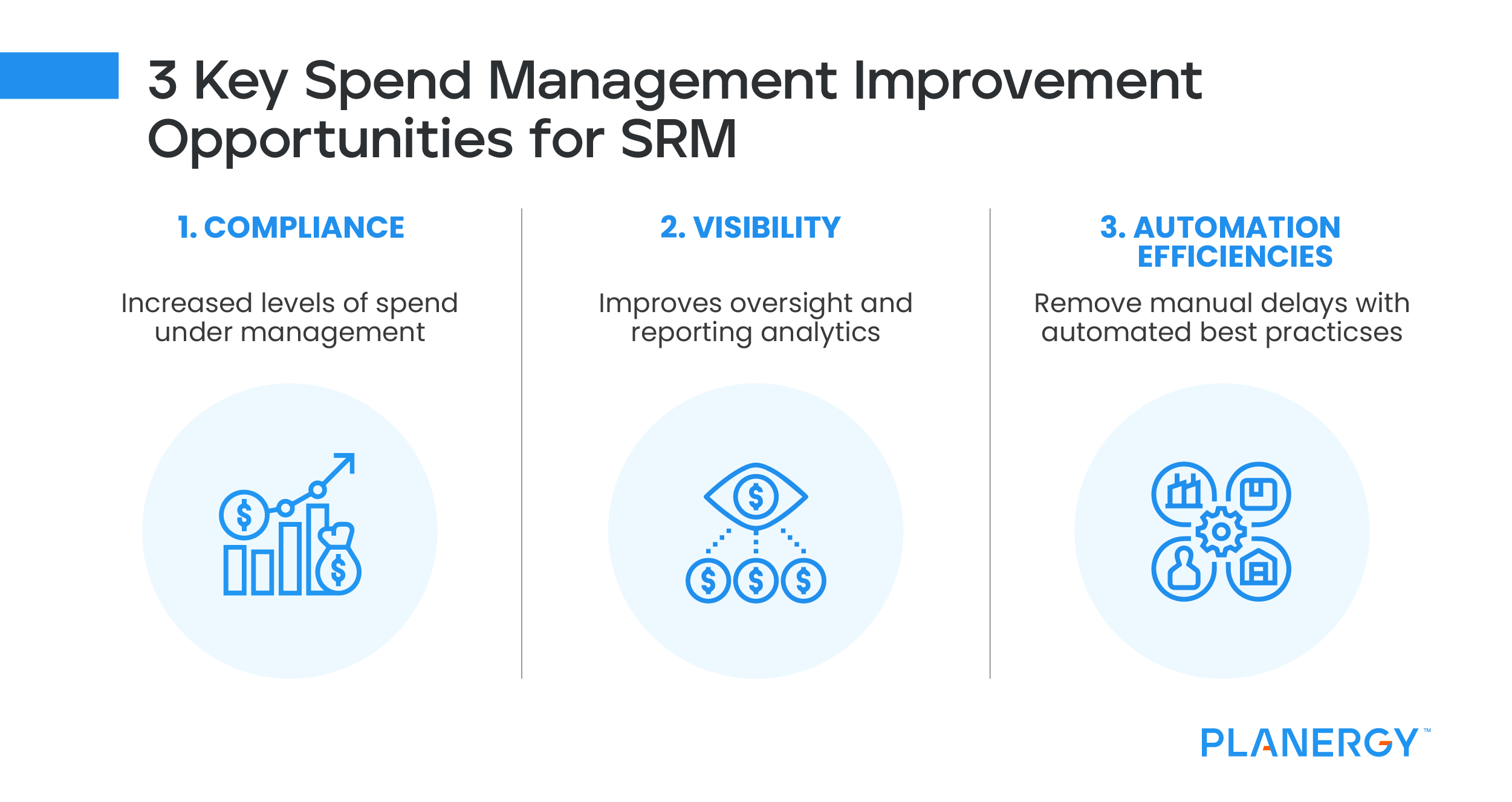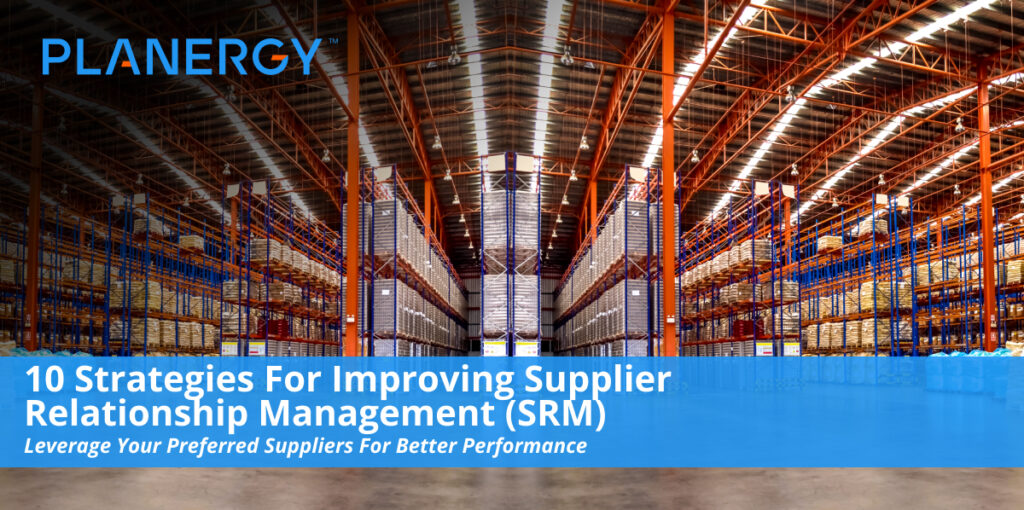Supplier relationship management (SRM), in simplest terms, refers to interacting with and managing third-party vendors that provide goods, materials, and services to your organization. It sounds easy enough—you choose suppliers that are cost-efficient and easy to work with to maximize the value of the business relationship.
Of course, like most modern business practices, it’s become much more complicated than that. Supplier management has gone through a major transition over the last few years because of growth in technology and the global scale of the economy. You have so many supplier choices that it’s hard to choose the best fit.
Using emerging strategies to streamline your supplier management system can help a lot. And we’ll discuss that, but to give a more rounded understanding of SRM, let’s go back to the start.
Early Supplier Relationship Management Solutions
The concept of SRM was first introduced in 1983 by McKinsey consultant Peter Kraljic, of Kraljic Matrix fame, in a Harvard Business Review article titled “Purchasing Must Become Supply Management.”
“Instead of simply monitoring current developments, management must learn to make things happen to its own advantage. This calls for nothing less than a total change of perspective: from purchasing (an operating function) to supply management (a strategic one),” Kraljic wrote.
This is essential to understanding of SRM. Relationships need to be strategic, they need to be growth-focused. That’s something that spend managers and senior staffers should never forget, whether they’re buying physical materials or software.
Approaches to Supplier Relationship Management
Later, in 1998, in study titled “An empirical investigation of supplier development: Reactive and strategic processes,” researcher Daniel R. Krause highlighted two approaches to the supplier management process:

Reactive Approach
Supplier relationships only when unpleasant situations with suppliers occur, and try to figure out how to improve the performance of unreliable suppliers. This approach consumes quite a lot of time and resources, which could have been better spent on more important business processes.
Strategic Approach
Where supplier relationship management starts even before an agreement with supplier is signed, in order to ensure the competitive advantage of the company in the long run.
Inputs from key stakeholders and initiatives for long term gain are implemented. This is a forward-focused approach with a strategic plan, which can lead to a successful relationship even in the early stages.
The strategic approach to supplier relationship management has always been key to successful businesses that rely on third-party suppliers, regardless of industry.
For example, by making long-term relationships and building trust with its suppliers an integral part of its supply chain strategy, Apple, developed a well-deserved reputation as a global leader in supply chain management, and ensured that it could deliver seamlessly in vast quantities when launching new products.
During the COVID pandemic the importance of supplier management and supply chain management came in to focus as an even more important priority than ever before with the impact on travel and global supply chains. Companies with a focus on strategic sourcing and strategic supplier relationship management were able to weather the storm in a much better way.
In this article, we are going to take a closer look at strategies that will help you improve relationships with key suppliers to create beneficial relationships, improve supplier performance, identify cost savings, and streamline your SRM workflow.
Instead of simply monitoring current developments, management must learn to make things happen to its own advantage. This calls for nothing less than a total change of perspective: from purchasing (an operating function) to supply management (a strategic one).
The Importance of Your Supplier Management System
Suppliers have a huge impact on a company’s success. Suppliers play a central role in driving revenue, and that should never be ignored. Being able to work with reliable, high-quality suppliers can help a business grow at scale. Unreliable suppliers can create bottlenecks in your workflow, and have a negative impact on your customers impression of your company.
There are a variety of types of suppliers a business can work with:
Wholesalers & Distributors
Wholesalers purchase large quantities of goods in bulk and then resell them in lower quantities for a higher unit price. They generally offer the lowest prices because they are selling in large quantities, and are reluctant to work with smaller orders.
Manufacturers & Vendors
These are suppliers who can handle the goods of several different companies. The prices might be higher than those of wholesalers, but they handle small orders from a wide range of manufacturers over a relatively short time period.
Import Sources
Domestic importers can work like domestic wholesalers and sell foreign goods to businesses.
There of course are more types of suppliers, but for the purposes of this article, it’s best to keep it simple. But no matter what types of suppliers your company is working with, they are all going to be important and most of the strategies to improve relationships can be used for all supplier types.
Now, let’s move onto some SRM strategies and solutions to better manage your supplier relationships.
Top 10 Strategies for Better Supplier Relationships
Having long-lasting, trusted relationships with dedicated suppliers should be a primary goal of any business that strives to succeed in the market, so let’s find out which strategies can help achieve this.
Treat Your Suppliers Like Partners
Suppliers are your partners, and this partnership should be based not only on financial transactions, but also on mutual trust and loyalty.
Make your suppliers feel like they are a part of your business. A two-way and win-win relationship is important, especially for your key suppliers. Share information with them about your processes, such as releases of new products and promotions, and listen to their concerns.
Timely Payments Are Crucial
If you don’t want to lose your suppliers, step one is making sure to pay them on time. Cash flow is important for their company just as it is for yours. This way, you will prove that you are a reliable customer and that you’re easy to work with.
If for any reason you cannot make the payment on a date agreed, then inform the supplier as soon as possible with the date on which they can expect the payment. While timely payment is preferred, good communication should be your fallback and will reduce any frustration for your suppliers.
Maintain Regular Communication
Relationships should be strong and deep. Make sure to maintain strong and regular communication with each of your key suppliers. Clear and frequent communication allows this communication to become more organic.
Keep them regularly informed and up to date, on your strategy and plans so that they know where they fit in and how they can help, plan for and benefit from those plans.
If you appreciate their work, let them know. If something’s not working for you, let them know. Good communication will ensure any problems can be addressed early and effectively.
Prioritize Value Over Price
Price is what you pay, value is what you get. Nothing is better for growing your profits than getting a quality service or materials for the right price. If you have the financial flexibility use it. You can buy in bulk and get better pricing but you will have more stock on your balance sheet and possibly an inventory management headache, or you can arrange to pay a vendor earlier in order to get a bigger discount.
Sometimes its better to pay a little more because the supplier is giving you a better service which pays for itself because you need to provide less time to manage them, will ensure disruptions are avoided, or because they can be trusted to deliver directly to your customer.
As noted in the previous section, relationships are important, but you shouldn’t stick with a supplier just because you like them. Choose the most efficient services for your business, and realize that efficiency is a product of value not just the cost.
Detailed and Fair Supplier Agreements
If you are buying from a vendor on a regular basis, Supplier Relationship Agreements with a strong contract management process is a must.Everything is fine, until it isn’t – so make sure you are covered by a contracted agreement.
Write down everything that both parties expect from your partnership such as Item or Service Description, Price, Delivery Terms, Payment Terms, Communications, and so on, and then have both parties sign it.
This can be a simple or complicated document depending on your business requirements. A well-documented Supplier Relationship Agreement will reduce the possibility of confusion or disputes. It’s often a good idea to create a flowchart or deck to explain the process to your team, so everyone knows their duties and can recognize if something goes wrong in the workflow.
If the agreement is reasonable and fair to both sides it will make it easier for the agreement to be followed. Avoid trying to enforce unreasonable expectations.
Get the Right Technology for the Job
Invest in supplier management software to keep track of information about your suppliers in one place. You can even go further and incorporate supplier management within a full Procure-to-Pay platform to track supplier performance KPIs. Software, like Planergy, integrates these supplier management solutions functions into the same platform.
Get the Right People and Process in Place
According to 2017 Global SRM Research Report by State of Flux, people and their soft skills are the core of SRM, so whether you need a whole department to manage vendor relationships, a dedicated Supplier Relationship Manager, or even if it’s only a part of someone’s role, having people in your organization who are responsible for the SRM process is essential.
Create a documented process that will help guide your team through the management and administration of suppliers. In a large organization this can include Flowcharts, SOPs, Policy Documents and agreements, or simply a 2 to 4 page document that covers all of the points of agreement for you and the vendor. Make sure that all the steps are followed and that documents are signed off when completed.
The report also states that 37% of supplier relationship specialists have a higher level of engagement from suppliers when they engage with them in this way, and this creates a stronger bond with the vendor, where both parties have a vested interest in maximizing the outcomes, and in turn helping to grow your business and reduce unnecessary business interruptions that can be a major time-suck for other business drivers.
Evaluate and Monitor the Risks
Always evaluate the risks of dealing with a supplier, and in particular a new supplier, especially if you have a complex supply chain.
Gathering the right supplier data is extremely important for supplier selection and evaluation. Ask for references, examples of their previous work, years in business, areas of expertise, how they deal with a crisis, what they did the last time they had to deal with a crisis, and so on.
Are they competitively priced? Do they have the right experience? Do they have the capacity to deal with your orders? Are they financially stable? These are just some of the questions you should be asking.
Maybe the supplier you select is not the cheapest but guarantees 100% on-time delivery with a money back offering; you can live with that because a chain is only as strong as its weakest link, and if your vendor lets you down you whole supply chain may be at risk, which can affect your ability to deliver to your customers.
In business, things go wrong, by evaluating your vendors risk profile and regularly reviewing it, you can mitigate the risks and be ready to deal with any emergencies in partnership with your vendors. This will help minimize interruptions to your business.
Think Global – Act Local
As the world becomes ever more connected, we increasingly find ourselves dealing with vendors that are further afield, either across the country or across the globe. Every city, state or country has different rules, laws and terminology.
For example Vendor is more commonly used in the USA while Supplier is the more frequently use term in Britain. In Brazil and many south American countries, every document must be stamped physically on receipt.
If some of your vendors are located in another country, then you and/or your SRM specialists should consider cultural differences when communicating with those suppliers. Attitude toward work always varies from culture to culture, so be aware of this and make sure that you are ok with this.
You should also consider differences in currency, VAT rates, and other financial differences. Finally, take into account the time zone differences, i.e. know about the time slots in which the supplier is available for communication.
Get Everyone Onboard
Having a Supplier Relationship Management Process is important but getting everyone in your organization on board is critical.
A report by American Express and AT Kearney estimated that $533 Billion a year is spent outside of proper procurement channels, this is called maverick spending, and it means that the procurement is not happening according to the agreements made with vendors, which results in additional costs.
Specifically it stated that while 95% of firms surveyed had preferred supplier lists, only 50% of them had procurement systems in place to enforce purchasing from their preferred suppliers.
Opportunities To Improve Spend Management Through Better Supplier Management
The American Express and AT Kearney report identified three key Spend Management opportunities:

Compliance
Improving control to ensure buying from preferred or contracted suppliers using a procurement solution like Planergy.
Spend Management Visibility
Not having everyone on board means missing data, and therefore poor spend visibility. If you don’t know how much is being spent with which vendors, and the details of what is being bought, it is impossible to accurately assess whether you are getting good service or value, and it’s difficult to compare vendors.
Automation Efficiencies
Merely automating is not enough. Getting everyone on board, trained and using best practice is a major opportunity.
This Is How You Improve Your SRM Workflow
Businesses should not underestimate supplier relationship management if they want to be successful. Every penny saved in efficient supplier management goes straight to the profit line.
The savings in time as well as cost should not be underestimated. Having a process, following best practice, and using spend management software will help you streamline your supplier relationship management, give your employees clear guidelines for purchasing, and allow them to spend more time on their key responsibilities, while giving your organization the insights necessary to continue to review and improve the value of your suppliers to your organization.
We hope these tips improve your SRM system and make your overall business more efficient. If we missed any strategies your organization uses for SRM, please share your strategies in the comments section to help make this an even more useful resource.




